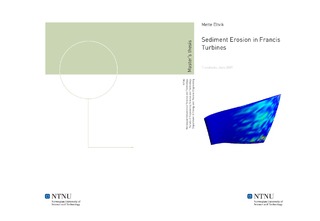Sediment Erosion in Francis Turbines
Master thesis
Permanent lenke
http://hdl.handle.net/11250/235485Utgivelsesdato
2009Metadata
Vis full innførselSamlinger
Sammendrag
The high concentration of sediments in the rivers near the Andes and the Himmalayas, is a large problems for run-of-river power plants. Small particles of quartz, which is a hard and sharp mineral, damage the turbine and causes reduced performance, shut downs of power plants and often extensive repairs. At Cahua power plant in Peru, turbine components need to be changed annually since as much as 50 kg/s of sediments passes through the turbines. Together with SN Power, Dynavec have installed a bolted turbine with a chemical coating, which desirable will reduce the maintenance interval.This master thesis has the objective of predicting sediment erosion in Francis turbines. By the use of CFD analysis of the stay, guide and runner vanes, the erosion areas and intensity can be found. This is investigated by implementing particles in the numerical simulationsand utilizing Langrangian particle tracking to predict the particles path through the turbine. With a numerical erosion model, the erosion areas and degree of intensity can be determined. Results show that the numerical simulations give reasonably prediction of erosion trends.Vulnerable areas are detected at the upper and lower covers and runner blade surfaces, which agrees with the observations at Cahua power plant. A comparison between the numerical and theoretical models for erosion on material is made with a verification model. The model is a high velocity jet test rig which test sediment influence on materials. The simulations indicate similar erosion trends, however, the erosion intensity rate does not agree with results from experiments.Sediment erosion is a highly complicated phenomena, and is dependent upon several factors. Numerical erosion models, will, with some modifications, give a good prediction of erosion areas and relative values of the erosion intensity. The simulations can be utilizedto predict the location of severe erosion and to estimate maintenance intervals.
